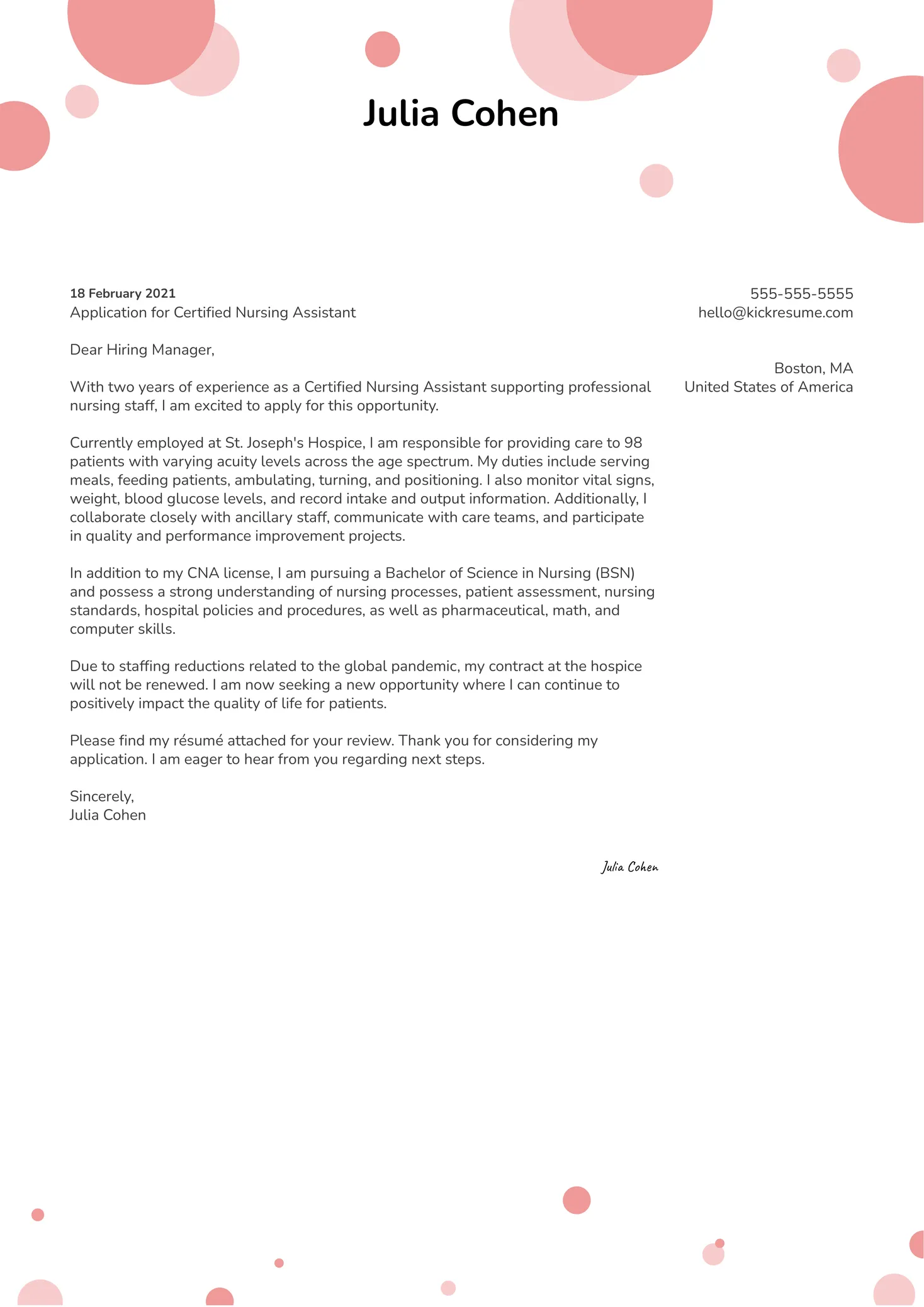What is a CNA Cover Letter
A Certified Nursing Assistant (CNA) cover letter is a vital document that accompanies your resume when applying for a CNA position. It serves as your introduction to a potential employer, providing a snapshot of your qualifications, skills, and experience. Unlike a resume, which lists your credentials, the cover letter gives you the opportunity to express your personality, demonstrate your passion for caregiving, and highlight why you’re the ideal candidate for the job. It’s your chance to make a strong first impression and persuade the hiring manager to read your resume and consider you for an interview. A well-crafted cover letter can significantly increase your chances of getting hired.
Purpose of a CNA Cover Letter
The primary purpose of a CNA cover letter is to introduce yourself and your qualifications to a potential employer. It allows you to explain how your skills and experiences align with the specific requirements of the job. It also provides an opportunity to showcase your personality, express your enthusiasm for the role, and demonstrate your understanding of the healthcare environment. Moreover, a cover letter allows you to address any potential gaps in your resume, such as a career change or a period of unemployment. Ultimately, the goal is to convince the hiring manager that you are the best fit for the position and to secure an interview.
Key Components of a CNA Cover Letter
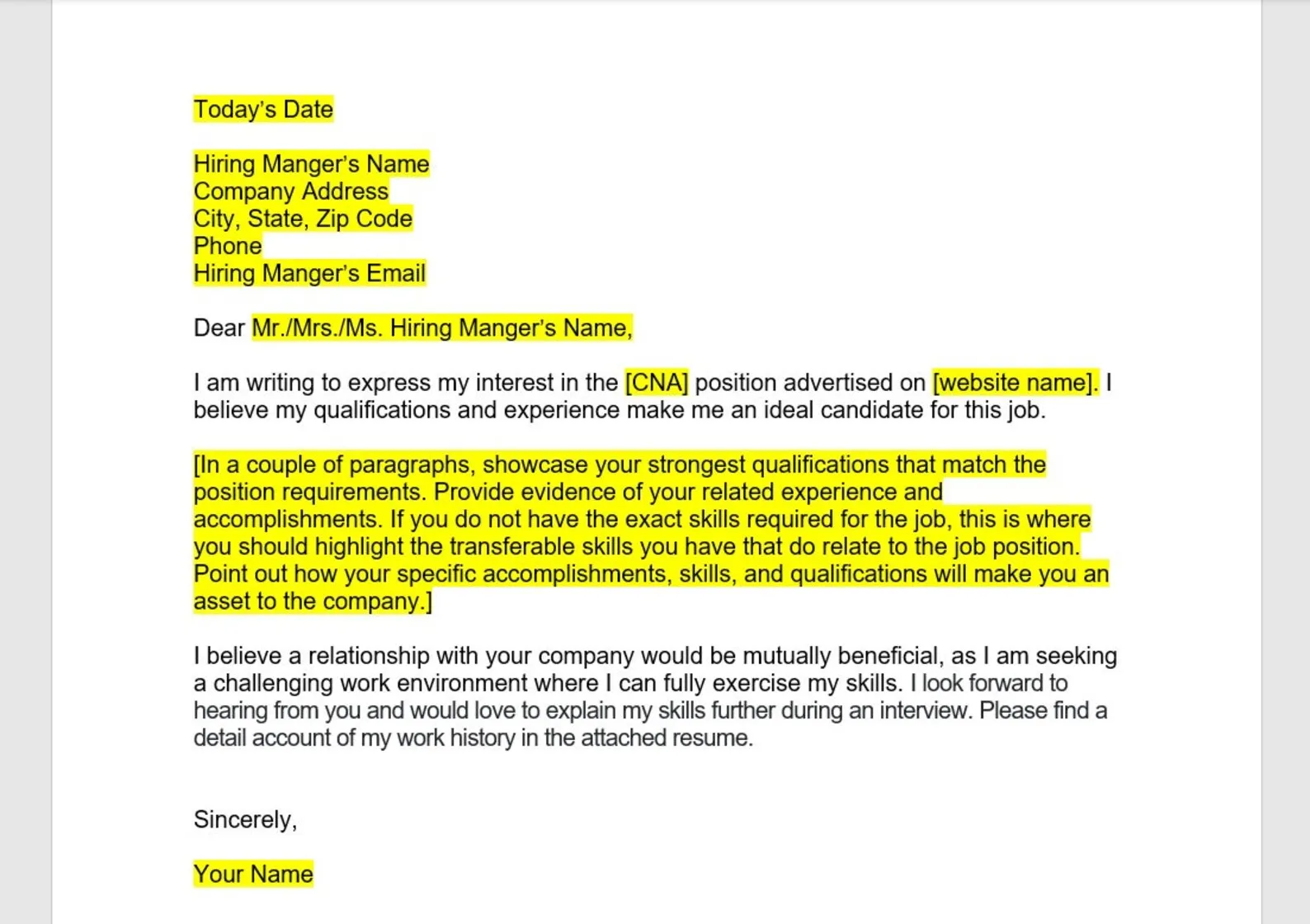
A well-structured CNA cover letter includes several key components that collectively present a compelling case for your candidacy. Each part plays a crucial role in conveying your qualifications and making a positive impression on the hiring manager. By paying attention to these elements, you can craft a cover letter that effectively highlights your skills and experience and increases your chances of landing an interview. From the contact information to the closing, each section should be clear, concise, and tailored to the specific job you are applying for. Using the right components and structuring the letter in a professional way is key to getting the recruiter’s attention.
Contact Information
At the very top of your cover letter, include your contact information. This should include your full name, address, phone number, and email address. Ensure that the information is accurate and up-to-date. Using a professional-sounding email address is essential. This section allows the hiring manager to easily contact you if they wish to schedule an interview. This section is essential for the employer to contact you and schedule an interview.
Applicant’s Information
This section provides the hiring manager with all the information required to reach you. Make sure it is easy to read and that there is no possibility of error. Double-check the phone number and the email address to avoid any issues. This also includes your name, making sure it is the same as listed on the resume.
Date of Writing
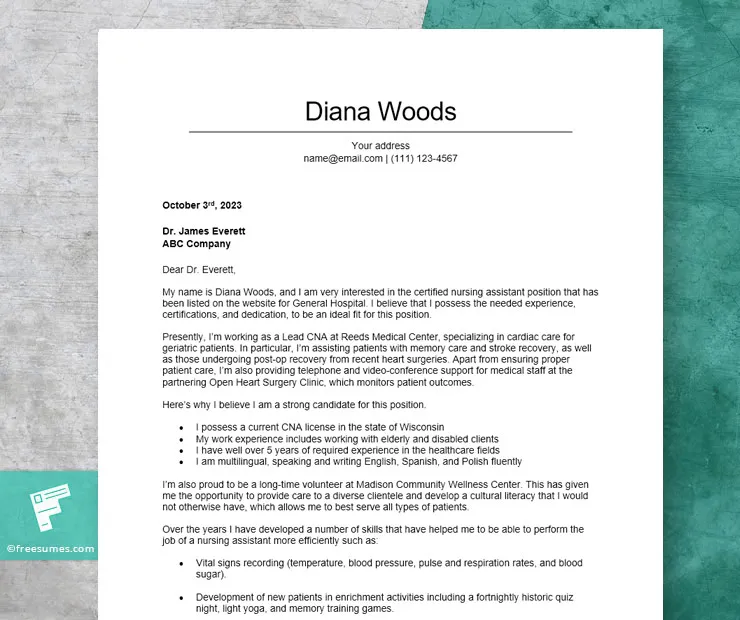
Always include the date on which you are writing the cover letter. This helps the employer know when the application was sent. The date usually goes below the contact information, before the recipient’s information. The date should be formatted correctly (e.g., Month Day, Year).
Greeting and Salutation
Start your cover letter with a professional greeting. If possible, address the letter to a specific person, such as the hiring manager’s name (research the company to find out). If you are unable to find the name, use a general greeting such as ‘Dear Hiring Manager’. Avoid generic greetings such as ‘To Whom It May Concern’ as they lack a personal touch. A personalized greeting shows that you have taken the time to research the company and the position.
Body of the Cover Letter
The body of your CNA cover letter is where you showcase your skills, experience, and passion for caregiving. It should be concise, well-organized, and tailored to the specific requirements of the job. Break the body into well-defined paragraphs, each with a clear purpose. This will make your cover letter easy to read and help the hiring manager quickly understand your qualifications. The body of your cover letter should contain details about why you are the best fit for the job.
First Paragraph - State Your Purpose
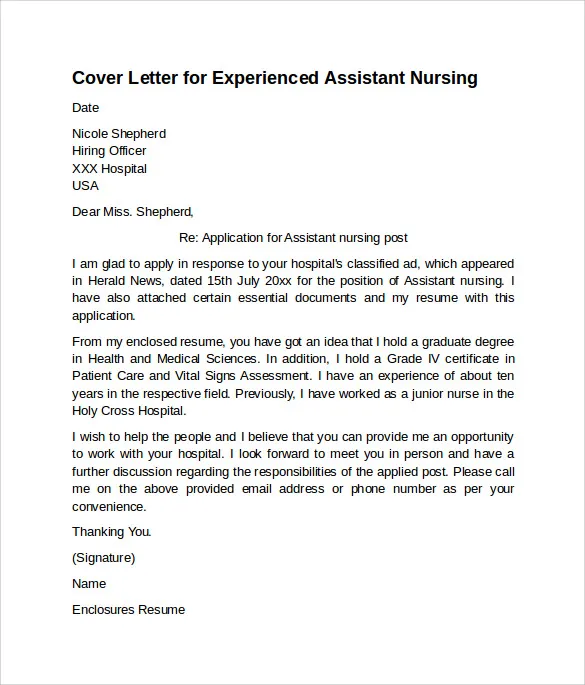
In the first paragraph, clearly state the purpose of your cover letter. Mention the specific CNA position you are applying for and where you found the job posting (e.g., online, through a referral). Briefly highlight your key qualifications or skills that align with the job requirements. This paragraph sets the tone for the rest of your letter and grabs the hiring manager’s attention by immediately stating your intentions. A strong opening will encourage the reader to continue reading and learn more about your qualifications.
Second Paragraph - Highlight Relevant Skills
The second paragraph is where you demonstrate how your skills and experience make you a strong candidate. Review the job description carefully and identify the key skills and qualities the employer is looking for. Provide specific examples from your previous experience to showcase these skills. Use action verbs to describe your accomplishments, such as ‘assisted patients with daily living activities,’ ‘monitored vital signs,’ or ‘provided compassionate care.’ Be as specific as possible, and quantify your achievements whenever possible.
Patient Care Experience
Highlight your experience in providing direct patient care. Mention the types of patients you have worked with (e.g., elderly, disabled, patients with specific medical conditions). Describe the tasks you performed, such as assisting with bathing, dressing, feeding, and mobility. Focus on your ability to provide compassionate and respectful care, promote patient independence, and maintain patient safety. Give specific examples of how you’ve handled challenging situations or provided exceptional care.
Technical Skills
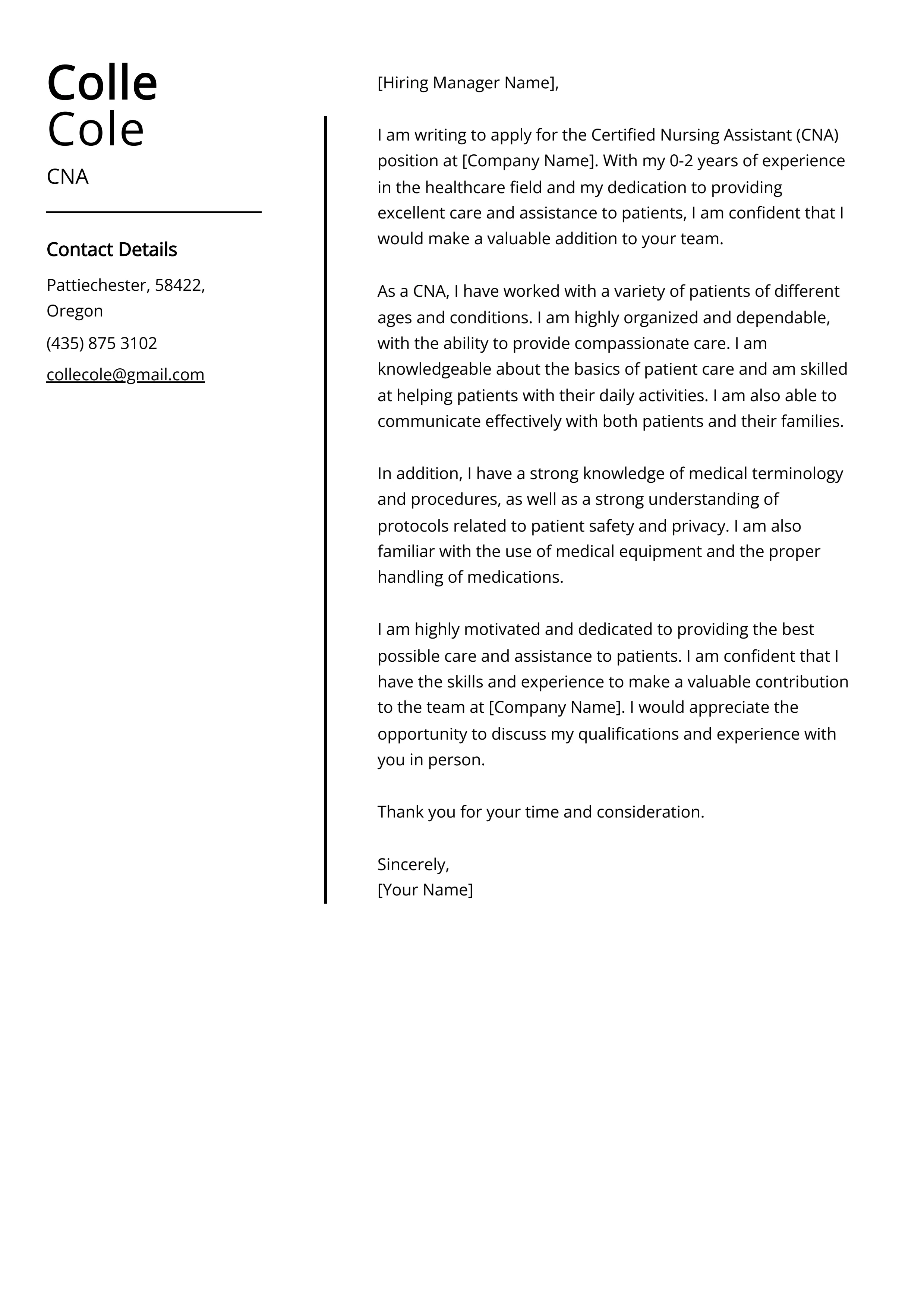
Detail your technical skills related to patient care. This may include taking vital signs, administering medications (if applicable and within your scope of practice), performing basic wound care, or assisting with medical equipment. If you have specific certifications or training (e.g., CPR, first aid), mention them here. Showcase your competence in these areas and emphasize your commitment to following medical protocols and maintaining patient safety.
Soft Skills
Emphasize your soft skills, which are crucial in healthcare. Highlight your communication skills (both verbal and nonverbal), empathy, patience, and ability to work as part of a team. Demonstrate your ability to handle stress, resolve conflicts, and maintain professionalism in challenging situations. Show that you are a reliable, responsible, and compassionate caregiver.
Third Paragraph - Showcase Accomplishments
Use the third paragraph to highlight your accomplishments and the positive impact you’ve made in previous roles. Quantify your achievements whenever possible, such as the number of patients you’ve assisted, the reduction in patient falls, or positive feedback you’ve received from patients or supervisors. Showcase your ability to go above and beyond your duties and contribute to a positive work environment. Providing concrete examples of your achievements will make your cover letter stand out and leave a lasting impression.
Closing of the Cover Letter
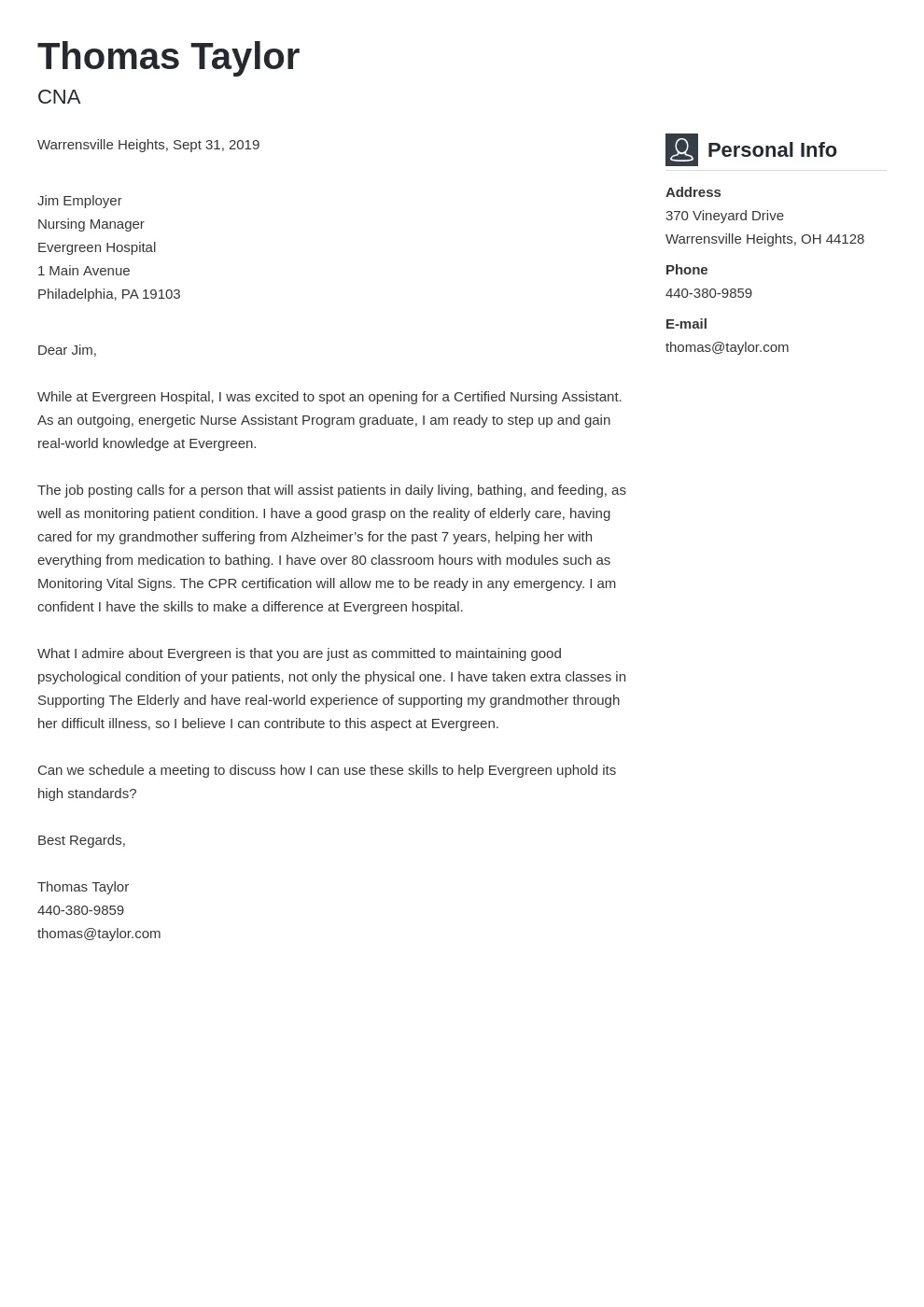
The closing of your cover letter should leave a positive and professional impression. It should reiterate your interest in the position and encourage the hiring manager to take the next step. This is your last chance to persuade the employer that you are the right candidate, so ensure it is concise and impactful. Avoid any unnecessary phrases and end with a clear call to action.
Express Gratitude
Start by expressing your gratitude for the hiring manager’s time and consideration. Thank them for reviewing your application and acknowledging their effort in the hiring process. This shows respect and professionalism. You can use a simple and sincere phrase, such as ‘Thank you for your time and consideration.’ This small gesture can make a significant difference in your application.
Call to Action
End with a clear call to action. Express your interest in an interview and provide your availability. This encourages the hiring manager to take the next step and contact you. You can use a phrase like ‘I am available for an interview at your earliest convenience’ or ‘I look forward to hearing from you soon.’ Make it easy for the employer to contact you by including your phone number and email address again if desired. Always finish the letter with a professional closing such as ‘Sincerely’ or ‘Respectfully’.
Formatting a CNA Cover Letter
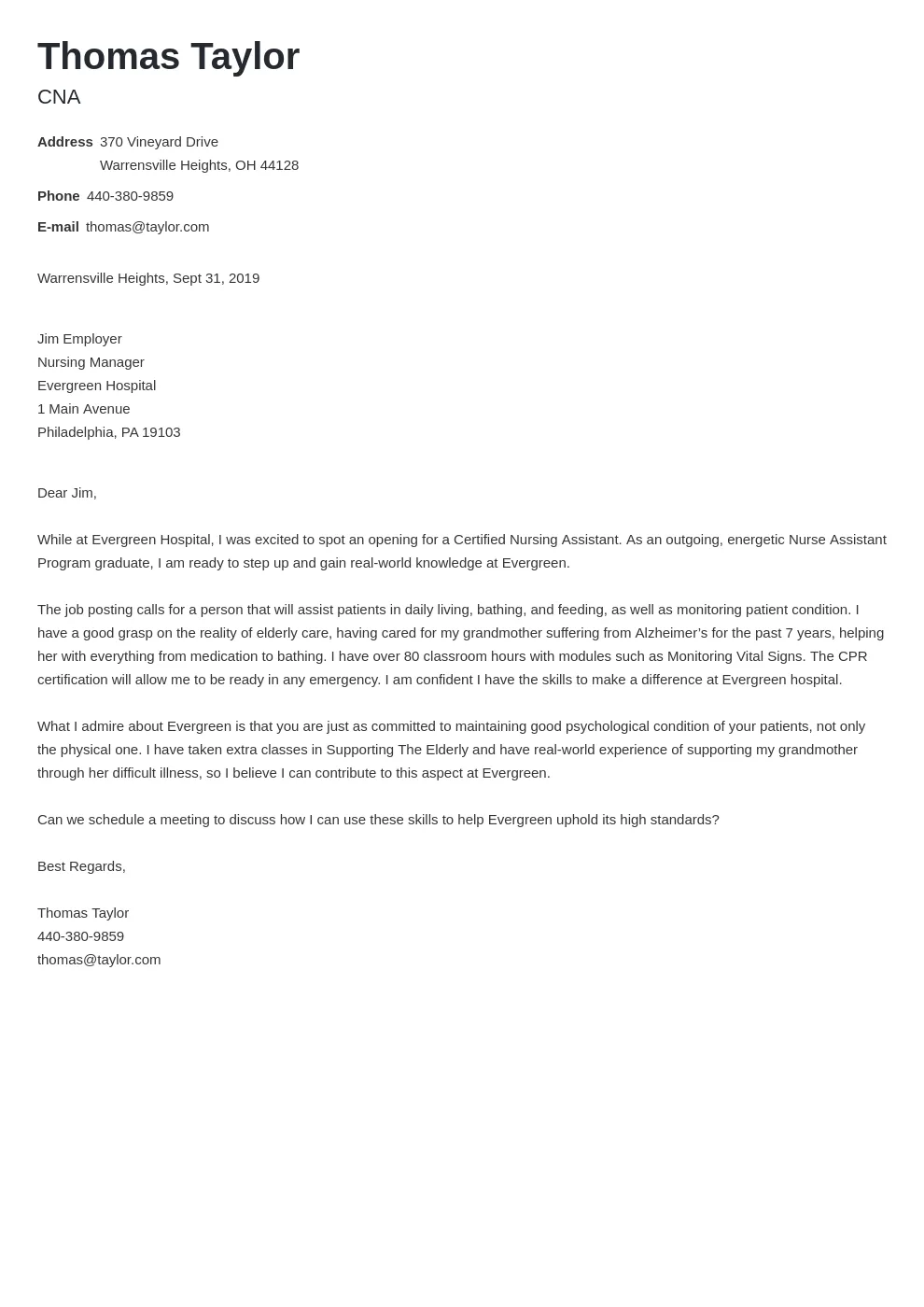
The formatting of your CNA cover letter is just as important as the content. A well-formatted letter is easy to read and reflects your professionalism. Pay attention to the font, size, margins, and spacing to create a visually appealing document. A clean and organized cover letter demonstrates your attention to detail and enhances your chances of making a positive impression. Following these formatting guidelines can increase your chances of landing an interview.
Font Selection
Choose a professional and easy-to-read font, such as Times New Roman, Arial, or Calibri. Stick to a standard font size, typically 11 or 12 points. Avoid using fancy or overly decorative fonts, as they can be distracting and make your letter difficult to read. Ensure the font is consistent throughout the letter. Clear, legible fonts help create a positive first impression and show that you value professionalism.
Font Size
Use a font size that is easy to read. A standard size is 11 or 12 points. Use a slightly larger font size (e.g., 14 points) for your name and contact information at the top of the letter. Ensure that the font size is consistent throughout the document. A consistent font size makes the letter look professional and readable. Avoid the use of multiple font sizes, as it may make the cover letter look cluttered.
Margins and Spacing
Use standard 1-inch margins on all sides of the page. Use single-spacing for the body of your cover letter, with a double space between paragraphs. This spacing makes the text easy to read and provides a clean and organized layout. Adjusting the spacing is key to a professional cover letter. Using consistent spacing also helps with readability and ensures the document looks professional.
Proofreading and Editing
Before submitting your CNA cover letter, carefully proofread and edit it. Check for any grammatical errors, spelling mistakes, and typos. Ensure that your sentences are clear, concise, and well-structured. Read the letter aloud to catch any awkward phrasing or inconsistencies. A polished and error-free cover letter demonstrates your attention to detail and professionalism. Ask a friend or family member to review your letter as well. Their fresh perspective can help you catch mistakes that you might have missed. Thorough proofreading is essential to a good cover letter.
By following these guidelines and examples, you can create a compelling CNA cover letter that highlights your skills and experience, and helps you secure your next job. Remember to tailor each cover letter to the specific job and company, and always proofread carefully before submitting. Good luck!
